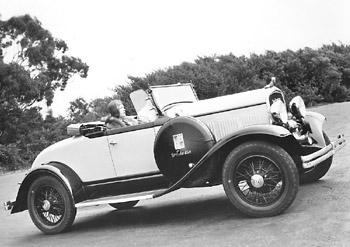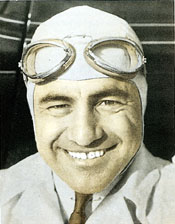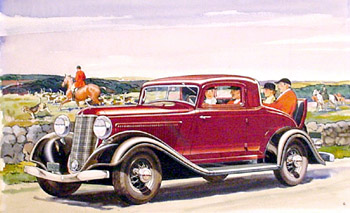|
by Dave Duricy |
||||||||
|
DeStart
|
||||||||
| DeStart | DeStreamliner | DeSuccess | DeSupply | DeSpeed | DeStuff | DeStop | ||||||||
Walter P. Chrysler introduced DeSoto in the summer of 1928. Chrysler's announcement immediately attracted 500 dealers. By the time DeSoto production was in full swing at the end of 1928, there were 1,500 agencies selling the premier 1929 DeSoto Six. Demand rocketed. During the first twelve months, DeSoto production set a record 81,065 cars. DeSoto built more cars during its first year than had Chrysler, Pontiac, or Graham-Paige. The record stood for nearly thirty years. The car name honored Hernando de Soto, the 16th century Spanish conquistador who discovered the Mississippi River. de Soto had covered more North American territory than any other early explorer, and his achievement is remembered by towns, cities and counties named DeSoto across the southeastern United States. As a moniker, DeSoto reinforced the Americana theme sounded by Chrysler's other new brand, Plymouth.
The car itself was a mid-price, six cylinder, 55 horsepower bargain. DeSoto provided engineering advantages such as an oil filter and Lockheed hydraulic brakes that were either optional or not offered by contemporary makes. DeSoto niceties included standard automatic windshield wiper, ignition lock, brake light, full-instrumentation, steering hub controls for headlights, and a tool kit with grease gun. It was a smooth package made more appealing by seven different models with swank names. The roadster was called Roadster Espanol. The deluxe sedan was called Sedan de Lujo. Even the basic two-door benefited as the Cupe Business. DeSoto returned for 1930 with even more. At the top of the line was the DeSoto CF, otherwise known as the DeSoto Eight. Here was a bigger DeSoto with a 114 inch wheelbase and the kind of inline eight cylinder engine customers expected to see in a luxury car. DeSoto called it "the world's lowest-priced straight eight" and promised customers "a vast reserve of power when you need it." With 70 horse power and 207.7 cubic inches, the DeSoto Eight delivered. Even though 1930 was the first full year of the Great Depression, the DeSoto Eight accounted for 20,075 DeSotos built.
How Chrysler Corporation in general and DeSoto Division in particular responded to The Depression is exemplary. Product development continued unabated, and the mood was still Jazz Age bright. DeSoto kept the public engaged by performing spectacular feats of speed and stamina. In 1932, race car driver Peter DePalo sped across the United States in ten days at the wheel of a DeSoto. When his journey ended, DePalo took his DeSoto for a 300 mile race-track spin hitting speeds as high as 80 miles per hour. In 1933, DeSoto recruited another race car driver for a more astounding publicity stunt. This time, Harry Hartz drove a DeSoto backwards across the country. Hartz peered his way across the continent through a rear window turned windshield.
Spectators couldn't know it at the time, but the Hartz trip was the first public manifestation of top-secret experiments brewing in the engineering laboratories of Chrysler Corporation. The results of those experiments would change the world. |
||||||||
| DeStart | DeStreamliner | DeSuccess | DeSupply | DeSpeed | DeStuff | DeStop | ||||||||



